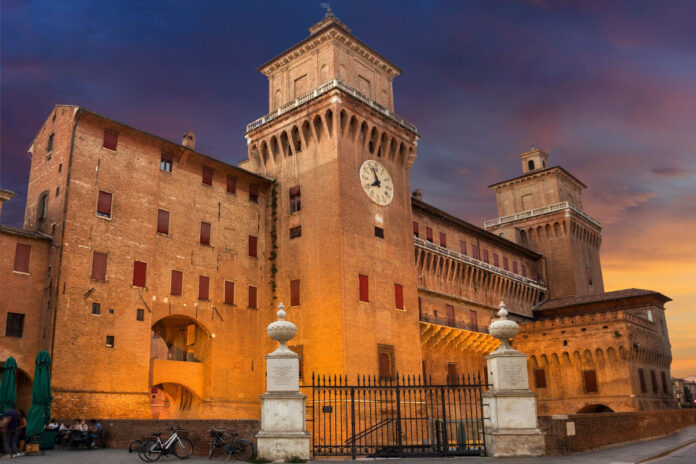Explore Ferrara, Italy – a UNESCO World Heritage site known for its Renaissance architecture, rich history, and vibrant culture. Learn about its unique attractions, delicious cuisine, and why Ferrara is a must-visit destination.
Nestled in the heart of the Italian Alps, Trento is a city that beautifully blends history, culture, and natural beauty. As the capital of the Trentino region, Trento boasts a rich heritage dating back to Roman times, stunning Renaissance architecture, and breathtaking views of the surrounding Dolomite mountains. Whether you’re exploring its historic streets, enjoying the local cuisine, or immersing yourself in the vibrant cultural scene, Trento promises an unforgettable experience.
A Brief History of Trento
Trento’s history is deeply rooted in its strategic location as a crossroads between Italy and Northern Europe. Originally founded as a Roman settlement, the city rose to prominence in the Middle Ages as a significant religious and political center. Trento’s most famous historical event is the Council of Trent (1545-1563), which played a crucial role in the Counter-Reformation and left a lasting impact on the city’s cultural and architectural landscape.
Must-See Attractions in Trento
Trento is a city rich in history and culture, with numerous attractions that offer a glimpse into its storied past and vibrant present.
Piazza Duomo
The heart of Trento is Piazza Duomo, one of the most beautiful squares in Italy. The square is surrounded by stunning buildings, including the Cathedral of San Vigilio, Palazzo Pretorio, and the Neptune Fountain. The cathedral, dedicated to Saint Vigilius, features a mix of Romanesque and Gothic architecture and is known for its beautiful frescoes and impressive rose window.
Buonconsiglio Castle
Buonconsiglio Castle is one of Trento’s most iconic landmarks. This impressive fortress served as the residence of the Prince-Bishops of Trento for centuries. The castle complex includes the Magno Palazzo, an exquisite Renaissance palace, and the Eagle Tower, adorned with stunning frescoes depicting the months of the year. The castle’s museum showcases a rich collection of art, artifacts, and historical exhibits.
Trento Science Museum (MUSE)
Designed by renowned architect Renzo Piano, the Trento Science Museum (MUSE) is a must-visit for science enthusiasts and families. The museum features interactive exhibits on natural history, technology, and sustainability. Its innovative design and engaging displays make it a favorite attraction for visitors of all ages.
Santa Maria Maggiore Church
The Santa Maria Maggiore Church is a significant historical site in Trento. Built in the 16th century, this church played a pivotal role during the Council of Trent. Its Renaissance architecture, beautiful frescoes, and historical significance make it a fascinating place to visit.
Trento’s Roman Ruins
Trento’s Roman heritage is still visible in several archaeological sites around the city. The Tridentum Roman Site, located beneath Piazza Cesare Battisti, offers a glimpse into the ancient Roman city with its well-preserved mosaics, streets, and buildings.
Exploring the Natural Beauty of Trento
Trento’s location in the Dolomites provides ample opportunities for outdoor activities and enjoying the stunning natural landscapes.
Monte Bondone
Monte Bondone is a popular destination for outdoor enthusiasts. In the winter, it offers excellent skiing and snowboarding opportunities. In the summer, visitors can enjoy hiking, mountain biking, and paragliding. The panoramic views from the top of Monte Bondone are simply breathtaking.
Lake Toblino
A short drive from Trento, Lake Toblino is a picturesque lake surrounded by mountains and vineyards. The lake is known for its clear waters, beautiful reflections, and the charming Toblino Castle. It’s a perfect spot for a relaxing day trip, offering opportunities for picnicking, walking, and photography.
The Adige River
The Adige River flows through Trento, providing a scenic backdrop for leisurely walks and bike rides. The riverside paths offer beautiful views of the city and the surrounding mountains. Kayaking and rafting are also popular activities on the Adige River.
Savoring Trento: Culinary Delights
Trento’s cuisine reflects its unique blend of Italian and Austrian influences, offering a variety of delicious dishes that highlight local ingredients and traditional recipes.
Local Specialties
- Canederli: Also known as bread dumplings, canederli are made with stale bread, milk, eggs, and various ingredients such as speck, cheese, or spinach. They are typically served in broth or with melted butter and sage.
- Strangolapreti: A type of dumpling made with spinach, bread, and cheese, strangolapreti are usually served with butter and sage sauce. The name means “priest stranglers” and has a fascinating historical background.
- Polenta e Funghi: A comforting dish made with creamy polenta and sautéed mushrooms, often flavored with garlic, herbs, and local cheese.
- Carne Salada: Thinly sliced, cured beef served raw as an appetizer or lightly cooked as a main course, typically accompanied by beans or potatoes.
Local Wines
Trento is part of the Trentino-Alto Adige wine region, known for its excellent wines. Be sure to try the local varieties such as Trento DOC, a sparkling wine made in the traditional method, and Teroldego Rotaliano, a robust red wine with a distinctive flavor.
Where to Stay in Trento
Trento offers a range of accommodations to suit different tastes and budgets, from charming bed and breakfasts to luxurious hotels.
Recommended Accommodations
- Grand Hotel Trento: A luxurious hotel located in the heart of the city, offering elegant rooms, a spa, and exceptional service.
- NH Trento: A modern hotel situated in the Le Albere district, designed by Renzo Piano. It features comfortable rooms, a fitness center, and beautiful views of the surrounding mountains.
- B&B Al Cavour 34: A charming bed and breakfast located in a historic building in the city center, offering cozy rooms and a welcoming atmosphere.
Practical Tips for Visiting Trento
- Best Time to Visit: Spring and fall are the best times to visit Trento, as the weather is mild and the crowds are smaller. Winter is perfect for skiing and snowboarding, while summer offers great opportunities for outdoor activities.
- Getting There: Trento is easily accessible by train from major cities like Verona, Venice, and Milan. The nearest airports are Verona Villafranca Airport and Venice Marco Polo Airport. Trento is also well-connected by road, making it easy to reach by car.
- Getting Around: Trento is best explored on foot, especially the historic center, which is compact and pedestrian-friendly. Biking is also a popular option, with several bike rental services available. Public transportation, including buses and a funicular, is efficient and convenient for getting around the city and its surroundings.
Trento’s Festivals and Events
Trento hosts several festivals and events throughout the year, offering visitors a chance to experience the local culture and traditions.
Important Festivals
- Festival dell’Economia: Held in June, this festival brings together economists, scholars, and the public for discussions, lectures, and debates on economic issues. The event attracts prominent speakers from around the world.
- Trento Film Festival: An annual film festival dedicated to mountain and adventure films, held in late April and early May. The festival features screenings, exhibitions, and cultural events.
- Feste Vigiliane: Celebrated in June, this festival honors Saint Vigilius, the patron saint of Trento, with religious processions, historical reenactments, fireworks, and various cultural events.
Exploring the Surrounding Area
Trento’s location in the Dolomites makes it a great base for exploring the surrounding area. Here are some nearby attractions worth visiting:
- Bolzano: A charming city known for its mix of Italian and Austrian cultures, beautiful architecture, and the South Tyrol Museum of Archaeology, which houses the famous Ötzi the Iceman.
- Riva del Garda: A picturesque town on the northern shore of Lake Garda, offering stunning views, water sports, and a charming historic center.
- Madonna di Campiglio: A renowned ski resort in the Brenta Dolomites, offering excellent skiing and snowboarding in the winter and beautiful hiking trails in the summer.
FAQs About Ferrara
Q: What makes Ferrara unique?
A: Ferrara is unique for its well-preserved Renaissance architecture, rich cultural heritage, and vibrant arts scene. The city’s blend of history, art, and natural beauty makes it a captivating destination.
Q: How many days should I spend in Ferrara?
A: A stay of 2-3 days is ideal to explore the main attractions, enjoy the local cuisine, and experience the city’s charm. However, you can easily spend more time if you plan to explore the surrounding area.
Q: Is Ferrara suitable for families?
A: Yes, Ferrara is family-friendly with plenty of historical sites, outdoor activities, and unique experiences that children will enjoy.
Wrapping Up Your Ferrara Adventure
Ferrara is a city that captivates with its timeless beauty and rich history. Whether you’re exploring the magnificent castles, wandering through the Renaissance streets, or savoring the local cuisine, Ferrara offers an unforgettable experience. Its blend of history, culture, and natural beauty makes it a hidden gem waiting to be discovered. So, pack your bags and get ready to explore the magic of Ferrara, Italy’s enchanting city of Renaissance splendor.
Visiting Ferrara is like stepping into a different era. The well-preserved architecture, vibrant cultural scene, and warm hospitality of the locals make it a must-visit destination in Italy. Whether you’re a history buff, a foodie, an art enthusiast, or just looking for a unique travel experience, Ferrara has something to offer everyone.

